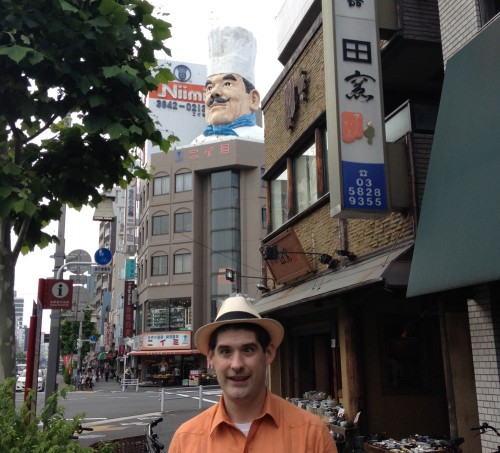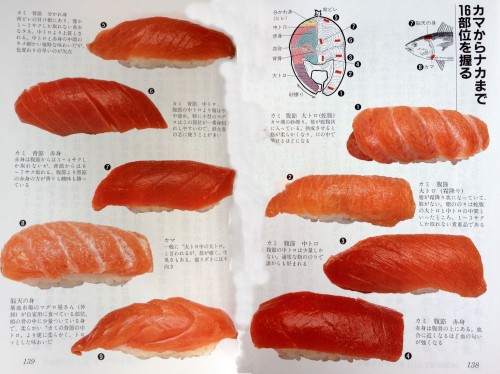By Dave Arnold
The Park Hyatt Hotel in Tokyo asked me to come over and make Booker and Dax style cocktails at their New York Bar. Nastassia and I made drinks and taught techniques for four nights, overlooking the city from the 52nd floor. If they ever offer to fly you over and set you up in a room, say yes immediately. It is the most baller hotel I’ve ever stayed in. Huge rooms, fantastic views, crazy good service. The Park Hyatt’s concierge is a serious bad-ass. In a city know for excellent service, he is one of the top concierges. He and his colleagues compete to see who can perform the most impossible tasks. For us he did the truly impossible: reservations for three non-Japanese people at Sukiyabashi Jiro with one day’s notice. Sukiyabashi Jiro is owned and run by Jiro Ono, who, at 86 years old, still works every day and doesn’t let anyone else mold the rice for his sushi. He won three Michelin stars at the age of 82. (Jiro and his restaurant are featured in the film Jiro Dreams of Sushi). If you don’t know about Jiro, read more here.
I don’t normally comment on restaurants on the blog, but I’m making an exception.
I wasn’t allowed to take pictures of the chef or restaurant, but shooting the sushi was OK — so here you go:

The meal that day was 19 pieces of sushi plus a slice of fancy melon.
Our party:

My thoughts in no particular order:
Melons:
I detest melon, but have been itching to try a fancy Japanese melon for a long time, just to see what the hubbub is about. Usually, the better a melon is, the more I hate it, because the more like a melon it tastes. I was able to tolerate this musk melon because of the absurd juiciness and high sugar level (apparent in the photo) that counterbalanced any strong melon flavor. The best part about the melon course was the spork. Jiro’s sporks are the finest I’ve ever used. He deserves his three Michelin stars on the sporks alone. I later found out they are available to anyone who makes the trip to Tokyo’s kitchen district, Kappabashi, in the Asakusa section of town.

The Timing:
The sushi courses came out at a rate of one per minute. 19 courses in 19 minutes. No ordering, no real talking –just making sushi and eating sushi. After the sushi is done you are motioned to leave the sushi bar and sit at a booth where you are served your melon. We took that melon at a leisurely 10 minute pace, leaving us with a bill of over $300 per person for just under 30 minutes time. Nastassia and Mark thought the pace was absurd and unpleasant. They felt obliged to keep up with Jiro’s pace. I didn’t feel obliged, but kept up anyway. I didn’t mind the speed. I could have easily eaten even faster, but I’m an inhuman eating machine –or so I’m told. At the end of the meal, Jiro went outside the restaurant and stood guard at the entrance, waiting to bid us formal adieu. This made Nastassia even more nervous about rushing to get out. Not me. At over 10 dollars a minute I have no problem letting an 86 year old man stand and wait for me to finish my melon if he wants to.
The Sushi:
Jiro’s sushi wasn’t what I expected. The vinegar level in the rice was much higher than what I’m used to. This is not a knock, just a statement. I presume the higher level of vinegar corresponds to an older style of sushi. The rice was as vinegar-ed as overnight rolled and pressed Kyoto-style saba (mackerel) sushi. Many of the courses also had a briny, ocean-like taste that I liked a lot.
Every piece of sushi was cut and prepped by Jiro’s son, then handed over to Jiro for the rice molding and sushi finishing. Jiro painted every piece with a glaze — his secret sauce. It went on everything but the anago, which, as expected, got a thicker, sweeter, glaze. I used no soy.
The cutting was a joy to behold. If you look at the sardine course (second row right side) you’ll get an idea of the skills. The skin gives way to two different presentations of muscle in one small piece. Two slicing things I picked up on: when cutting the squid, the chef’s yanagi (slicer) entered the flesh at an extreme angle –the cutting style I’m used to. Just before the squid was cut all the way through, he righted his knife perpendicular to the cutting board. It struck me that this prevented ragged edges. The other trick for which I have not figured out the reason is Jiro’s slicing of the large prawn pieces. Jiro molded the prawns as one big piece of sushi and then cut them in half. He cut about two-thirds of the way through and then stopped. He slapped the top of his slicer to finish the cut. Must be important, but don’t know why. Could it be to prevent smearing the rice?
The fish was impeccably fresh –as it should have been — but the mantis shrimp course was not tasty and the anago was just OK. The mantis, or squilla mantis, as it is sometimes called, was mealy and thoroughly unpleasant. Somebody else made the same comment on the web. I have have never had a mantis shrimp I thought was good, and I don’t think my western taste buds are to blame –I think they just mostly suck. Mark, however, had one the next day that he liked a lot. I was looking forward to the anago, as I am a fiend for eel in almost any form, but this one was a bit mushy. Still good — but not great. The rest of the meal was fantastic.
The Book:
Jiro has a book. You should try to find it. Even without understanding a single Japanese character you’ll learn a lot. Here are some pages.



Next stop… Tsukiji Market

Dave — lucky you, getting to Jiro’s!
We did a similar run through the menu recently as well. If you’re interested:
http://www.cnngo.com/tokyo/eat/whats-it-eat-sukiyabashi-jiro-worlds-best-sushi-bar-282966
Oh, and we also featured you the other day too 🙂
http://www.cnngo.com/tokyo/drink/liquid-tokyo/new-yorks-mad-scientist-drinks-experiments-tokyo-850122
Nice. Thanks a lot. I hadn’t seen that article. Although I enjoyed meeting Nick a lot and mining him for information on Japanese bar techniques.
That is so crazy! What an incredible opportunity! And thanks for the heads up about the book — I’m going to try to track it down. If it helps, the first 2 kanji have furigana (reading characters) next to them and says “Sukiyabashi”. I can only assume the next kanji is Jiro. Then “wo” (to show possession), and a kanji that is presumably a verb because the last character is “ru” (usually a verb ending). Cheers!
To add to my previous comment, I used my trusty kanji dictionary to discover that the book is called “Sukiyabashi jirÅ shun o nigiru”. And I will be swinging by my local Kinokuniya to snag a copy 🙂 Once again, thanks so much for sharing about your experience!
Dave, I can’t remember the radio show e-mail address, but I have answers to the horchata question you had two or three weeks ago. What is the best way to get this to you?
-ET
Hello E.T. Send to lopez.nastassia@gmail.com with radio show question in subject, or twiter me at @cookingissues. As a last resort, put it here. Thanks, look forward to hearing.
Thanks, Dave. Just sent the response. I hope it is helpful. I sent it with “answer to your listener’s horchata question” as the subject line because I fail at reading. I hope it will make its way through anyway.
It’s kind of funny that Jiro’s decided he needs to make a pile of cash and all of his local suckers are dying off… So he had this film made where he makes sure silly westerners don’t learn about how much he hates them and now they all go and pay his prices for sushi at a quality available elsewhere for Y13,500 for a leisurely meal of 25+ pieces.
Glad to see a few fresh posts. This blog is one of the reasons I started my own cooking blog. I thought you might be done for good with that salt post that stayed up forever.
If you’re not being facetious about knowing the name of the sushi book, best as I can tell, is “Sukiyabashi Jiro Shun Onigiru” – Sukiyabashi Jiro Makes Seasonal Sushi (loose translation). Author is Shinzo Satomi.
Or, I could just read through the comments and see where it’s been answered three-weeks ago.
Here you go. better late than never!!!
https://bookweb.kinokuniya.co.jp/guest/cgi-bin/wshoseaohb.cgi?W-NIPS=9975044840&AREA=02&LANG=E
just add to your cart on the right hand side. Delivery charge is $6.00 US.